ZHCSC02H September 2012 – September 2015 LM3642
PRODUCTION DATA.
- 1 特性
- 2 应用
- 3 说明
- 4 修订历史记录
- 5 Pin Configuration and Functions
- 6 Specifications
- 7 Detailed Description
- 8 Application and Implementation
- 9 Power Supply Recommendations
- 10Layout
- 11器件和文档支持
- 12机械、封装和可订购信息
8 Application and Implementation
NOTE
Information in the following applications sections is not part of the TI component specification, and TI does not warrant its accuracy or completeness. TI’s customers are responsible for determining suitability of components for their purposes. Customers should validate and test their design implementation to confirm system functionality.
8.1 Application Information
The LM3642 can drive one flash LED at currents up to 1.5 A. The 4-MHz DC-DC boost regulator allows for the use of small value discrete external components.
8.2 Typical Application
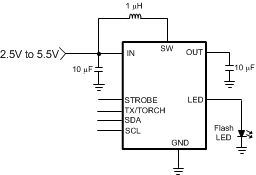 Figure 17. Typical Application Circuit
Figure 17. Typical Application Circuit
8.2.1 Design Requirements
Example requirements based on default register values:
Table 2. Design Parameters
| DESIGN PARAMETER | EXAMPLE VALUE |
|---|---|
| Input voltage range | 2.5 V to 5.5 V |
| Brightness control | I2C Register |
| LED configuration | 1 Flash LED |
| Boost switching frequency | 4 MHz |
| Flash brightness | 1.5 A maximum |
Table 3. Application Circuit Component List
| COMPONENT | MANUFACTURER | VALUE | PART NUMBER | SIZE | CURRENT/VOLTAGE RATING (RESISTANCE) |
|---|---|---|---|---|---|
| L | TOKO | 1 µH | DFE201610C | 2 mm × 1.6 mm × 1 mm | 2.5 A |
| COUT | Murata | 10 µF | GRM188R60J106M | 1.6 mm × 0.8 mm × 0.8 mm (0603) | 6.3 V |
| CIN | |||||
| LED | Lumiled | PWF-4 | VF = 3.6 V, @1.5 A |
8.2.2 Detailed Design Procedure
8.2.2.1 Output Capacitor Selection
The LM3642 is designed to operate with at least a 10-µF ceramic output capacitor. When the boost converter is running the output capacitor supplies the load current during the boost converter's on-time. When the NMOS switch turns off the inductor energy is discharged through the internal PMOS switch, supplying power to the load and restoring charge to the output capacitor. This causes a sag in the output voltage during the on-time and a rise in the output voltage during the off-time. The output capacitor is therefore chosen to limit the output ripple to an acceptable level depending on load current and input/output voltage differentials and also to ensure the converter remains stable.
For proper operation the output capacitor must be at least a 10-µF ceramic. Larger capacitors such as a 22-µF capacitor or capacitors in parallel can be used if lower output voltage ripple is desired. To estimate the output voltage ripple considering the ripple due to capacitor discharge (ΔVQ) and the ripple due to the capacitors ESR (ΔVESR) use the following equations:
For continuous conduction mode, the output voltage ripple due to the capacitor discharge is:

The output voltage ripple due to the output capacitors ESR is found by:

In ceramic capacitors the ESR is very low so a close approximation is to assume that 80% of the output voltage ripple is due to capacitor discharge and 20% from ESR. Table 4 lists different manufacturers for various output capacitors and their case sizes suitable for use with the LM3642.
8.2.2.2 Input Capacitor Selection
Choosing the correct size and type of input capacitor helps minimize the voltage ripple caused by the switching of the LM3642 device’s boost converter, and reduces noise on the boost converter's input terminal that can feed through and disrupt internal analog signals. In the typical application circuit a 10-µF ceramic input capacitor works well. It is important to place the input capacitor as close as possible to the LM3642 device’s input (IN) pin. This reduces the series resistance and inductance that can inject noise into the device due to the input switching currents. Table 4 lists various input capacitors that are recommended for use with the LM3642.
Table 4. Recommended Input and Output Capacitors (X5R/X7R Dielectric)
| MANUFACTURER | PART NUMBER | VALUE | CASE SIZE | VOLTAGE RATING |
|---|---|---|---|---|
| TDK Corporation | C1608JB0J106M | 10 µF | 0603 (1.6 mm × 0.8 mm × 0.8 mm) | 6.3 V |
| TDK Corporation | C2012JB1A106M | 10 µF | 0805 (2 mm × 1.25 mm × 1.25 mm) | 10 V |
| TDK Corporation | C2012JB0J226M | 22 µF | 0805 (2 mm × 1.25 mm × 1.25 mm) | 6.3 V |
| Murata | GRM188R60J106M | 10 µF | 0603 (1.6 mm × 0.8 mm × 0.8 mm) | 6.3 V |
| Murata | GRM21BR61A106KE19 | 10 µF | 0805 (2 mm × 1.25 mm × 1.25 mm) | 10 V |
| Murata | GRM21BR60J226ME39L | 22 µF | 0805 (2 mm × 1.25 mm × 1.25 mm) | 6.3 V |
8.2.2.3 Inductor Selection
The LM3642 is designed to use a 1-µH or 0.47-µH inductor. Table 5 lists various inductors and their manufacturers that can work well with the LM3642. When the device is boosting (VOUT > VIN) the inductor will typically be the largest area of efficiency loss in the circuit. Therefore, choosing an inductor with the lowest possible series resistance is important. Additionally, the saturation rating of the inductor should be greater than the maximum operating peak current of the LM3642. This prevents excess efficiency loss that can occur with inductors that operate in saturation. For proper inductor operation and circuit performance, ensure that the inductor saturation and the peak current limit setting of the LM3642 are greater than IPEAK in the following calculation:

where ƒSW = 4 MHz, and efficiency can be found in the Typical Characteristics plots.
Table 5. Recommended Inductors
| MANUFACTURER | L | PART NUMBER | DIMENSIONS (L×W×H) | ISAT | RDC |
|---|---|---|---|---|---|
| TOKO | 1 µH | DFE252010C | 2.5 mm × 2 mm × 1 mm | 2.7 A | 78 mΩ |
| TOKO | 1 µH | DFE252012C | 2.5 mm × 2 mm × 1.2 mm | 3 A | 59 mΩ |
| TOKO | 0.47 µH | DFE201612C | 2 mm × 1.6 mm × 1.2 mm | 3.4 A | 82 mΩ |
| TOKO | 1 µH | DFE201610C | 2 mm × 1.6 mm × 1 mm | 2.5 A | 79 mΩ |
8.2.3 Application Curves
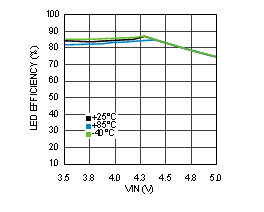 Figure 18. Flash LED Efficiency vs. VIN
Figure 18. Flash LED Efficiency vs. VIN
VLED = 3.8 V, ILED = 1.5 A
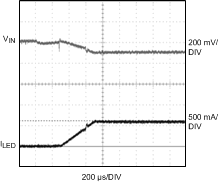 Figure 20. Input Voltage Flash Monitor Stop and Hold Mode with Default Settings
Figure 20. Input Voltage Flash Monitor Stop and Hold Mode with Default Settings
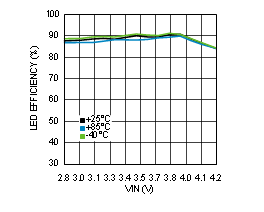 Figure 19. Torch LED Efficiency vs. VIN
Figure 19. Torch LED Efficiency vs. VIN
VLED = 3.7 V, ILED = 375 mA
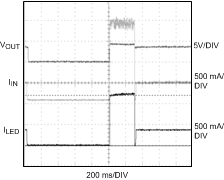 Figure 21. Flash Mode to Torch Mode Transition
Figure 21. Flash Mode to Torch Mode Transition
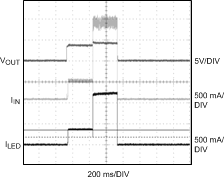 Figure 22. Torch Mode to Flash Mode Transition
Figure 22. Torch Mode to Flash Mode Transition
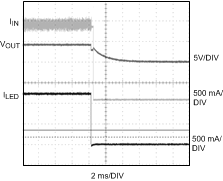 Figure 24. VLED Short Fault
Figure 24. VLED Short Fault
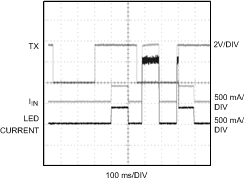 Figure 26. TX Transition Plot Behavior of LED Current Shown on Enabling the Part in a TX Event and Upon TX Interrupting During a Flash
Figure 26. TX Transition Plot Behavior of LED Current Shown on Enabling the Part in a TX Event and Upon TX Interrupting During a Flash
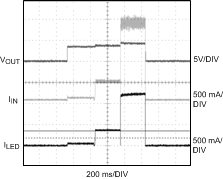 Figure 23. Indicator Mode - Torch Mode - Flash Mode Transitions
Figure 23. Indicator Mode - Torch Mode - Flash Mode Transitions
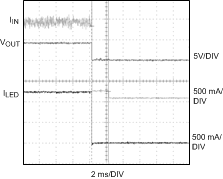 Figure 25. VOUT Short Fault
Figure 25. VOUT Short Fault